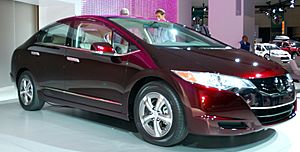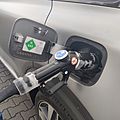Hydrogen car facts for kids
A hydrogen car is a special kind of vehicle that uses hydrogen as its fuel to make it move. It's not just cars; other vehicles like aircraft can also use hydrogen in a similar way. These vehicles are designed to be very clean, producing almost no pollution.
Contents
What is Hydrogen Energy?
Hydrogen is the simplest and most common element in the whole universe. Even though there's a lot of it, hydrogen doesn't exist as a pure gas on Earth. It's always mixed with other elements, like in water (H₂O). Hydrogen holds a lot of energy. When an engine burns pure hydrogen, it creates almost no pollution, which is great for our planet!
Why is Hydrogen a Good Fuel?
- Hydrogen can be made from water by splitting it into oxygen and hydrogen. This means we have an almost endless supply!
- When hydrogen burns, the only thing it produces is water. This means it doesn't create harmful gases like carbon dioxide, which gasoline and diesel cars produce.
- Hydrogen itself is not poisonous. If it leaks, it's safer than many other gases.
What are the Challenges with Hydrogen Energy?
- It's hard to store the large amount of hydrogen needed to power a car.
- Sometimes, hydrogen is made using energy from fossil fuels. This means the process of making hydrogen isn't always completely clean.
How Do Hydrogen Cars Work?
What is a Fuel Cell?
Think of a fuel cell like a special kind of battery. It changes the chemical energy from a fuel directly into electricity and heat. But unlike a regular battery, a fuel cell doesn't run out or need recharging. It keeps making electricity as long as it has fuel.
The Fuel Cell Principle
A fuel cell has two main parts called electrodes, with a special material called an electrolyte in between. Oxygen goes over one electrode, and hydrogen goes over the other. This process creates electricity, water, and heat.
Inside, there's a special membrane that only allows tiny charged particles to pass through. The electrodes are coated with a catalyst, which helps the chemical reaction happen. Hydrogen gas flows into one side and oxygen gas into the other. The catalyst helps the hydrogen give up its electrons. These electrons then flow through an outside circuit, creating electricity!
Solving Problems for Hydrogen Cars
One of the biggest challenges for hydrogen cars is how to store enough hydrogen. If a car uses a fuel cell, it's less of a problem. But if it burns hydrogen directly in an engine, storage is very important.
Scientists are working on ways to store hydrogen using special materials called metal hydrides. These materials can absorb and release hydrogen. While this technology is getting better, it still can't store enough hydrogen for what car users need. So, finding better ways to store hydrogen is a big goal for the future!
Images for kids
-
The Boeing Fuel Cell Demonstrator was powered by a hydrogen fuel cell.
-
The Hyundai Nexo is a hydrogen fuel cell-powered crossover SUV.
-
Refueling a hydrogen-powered vehicle, a Hyundai Nexo. Notice the condensation around the handle, caused by the hydrogen gas expanding and making the handle very cold.
See also
 In Spanish: Vehículo de hidrógeno para niños
In Spanish: Vehículo de hidrógeno para niños











